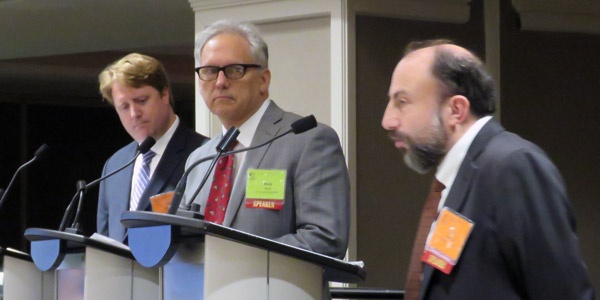By Rich Heidorn Jr.
WASHINGTON — “Pernicious subsidy” or “rough justice”?
Audience members got to decide for themselves how to characterize net metering for rooftop solar generation during a debate at the Energy Bar Association’s Mid-Year Energy Forum last week.
Richard L. Roberts, head of the electric group at Steptoe & Johnson, said it’s unfair that rooftop solar owners are paid retail prices as high as $0.13/kWh for the power they inject into the grid while central station generators are paid wholesale rates of about $0.04/kWh.

Left to right: Hennessey, Glick and Roberts | © RTO Insider
As a result, a customer whose solar panels generate energy equal to their consumption for the month “pays nothing for their electric service. They pay nothing for the reserves that they’ve been given. They pay nothing for transmission. They pay nothing for distribution. They pay nothing for public purpose programs, all of which go into retail service.”
Scott Hennessey, SolarCity’s regulatory counsel and vice president of policy and electricity markets, responded by citing a Sept. 30 ruling by the Massachusetts Department of Public Utilities last week that he said found rooftop solar provided more benefits than costs to the state’s grid. (See related story, Regulators Reject DER Surcharge in Rate Case.)

Glick | RTO Insider
He dismissed as a “common trope” the notion that rooftop solar is only for the “wealthy and well meaning.” The introduction of smart inverters allows rooftop solar to provide voltage support and other services to the grid, he said, while the introduction of financing options makes it available to the middle class.
Also participating in the discussion — though not staking a position on either extreme — was Mark Glick, administrator for the State Energy Office in Hawaii, a state that has provided a cautionary tale for regulators as generous subsidies have threatened to overwhelm the islands’ grids with solar generation.
Utility-Scale vs. Distributed Solar

The session, moderated by Caileen Gamache of Chadbourne & Parke and Matthew R. Rudolphi of Duncan, Weinberg, Genzer & Pembroke, also touched on the virtues of distributed versus centralized solar generation.
“The question of whether or not [rooftop solar is] harmful to the grid or harmful to the average consumer I would turn around,” Hennessey said. “When you have infrastructure purchased by a utility and then spread across the entire rate base — with a fat profit, by the way, for the utility — that is a choice made decades in advance — and I think we’ve seen now, not always with the best of foresight,” he said. “Whereas when you have solar and the other distributed energy resources I’ve mentioned, that’s private investment in infrastructure that then benefits everyone around, with less peaking generation required.”
Hennessy said utilities that want to develop large-scale solar should be required to use a nonutility business unit rather than competing with other developers by using the utility’s low cost of capital and other advantages.
“What we’ve found is that every time they have tried that they have failed and they’ve had to close up shop, as [Arizona Public Service] did in Arizona.”
Jurisdictional ‘Mess’

Roberts said the Supreme Court’s FERC v. Electric Power Supply Association ruling, which preserved FERC’s right to regulate demand response, left a “jurisdictional mess” because the commission has no authority over net metering sales. Such sales should be a FERC-regulated wholesale sale under the Public Utility Regulatory Policies Act (PURPA), he said.
Roberts also cited studies showing utility-scale solar is two to three times more efficient than rooftop solar.
The rush to distributed generation could repeat the kind of mistakes California regulators made with the first retail choice program in the 1990s, which resulted in overpayments to qualifying facilities under PURPA and politicized integrated resource processes, he said.
“The goal of grid modernization should be to allow — without preferences or without predetermining who’s the winner and who’s the loser — equal access to all of these forms of technology to compete against each other and then wait and see where the next innovations come from,” he said.
“Nobody knows what the next big technological breakthrough is going to be. It might be large-scale generation, and if we’ve skewed our investments in the grid toward microgrid or small-scale [generation], we could find ourselves once again looking at investments and wondering why we did that.”
Hawaii’s Glick said “there’s no doubt” that utility-scale solar is cheaper than distributed resources. “But ultimately that will change and we have to allow the market to develop while that change occurs,” he said.



